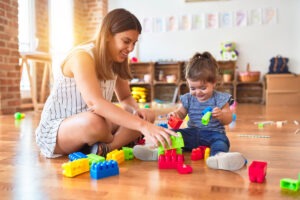Speech in the Car:
- Talk!
- Describe or narrate what you’re doing. “I need to find my keys so we can turn on the car”. Your child listens to everything you say, so being a good model is a great way to develop their speech and language skills.
- Sing!
- Think about songs you learned in school like the ABCs or the months of the year. Here are some of our favorites: The Wheels on the Bus, the Itsy Bitsy spider, Mary Had a Little Lamb, Five Little Ducks, and Twinkle Twinkle Little Star.
- Play!
- For kids in pre-k and up “I Spy” is a classic.
- “What rhymes with ___” or asking your child to think of rhyming words. This encourages their phonological awareness skills; important for reading.
- Categories: challenge your child to think of items in a category, like food, sports, clothes, etc.
- “5 Questions:” similar to 20 Questions. With this game, use a Semantic Analysis approach (ask what is the category, where do you find it, what is it made of, what does it do, and what is something you associate with it). Incredible for vocabulary development!
Speech in the Grocery Store:
- Food Groups – a step up from a simple category game. Can you name 3 types of dairy? 3 grains? Etc.
- Scavenger Hunt – a step up from I Spy. Who can find all the items on our grocery list? Go a step further and ask, “where do you find this food in nature?” Apples grow on trees, milk comes from cows, etc.
- Plan a Dinner – what would your little one make if THEY were in charge of making dinner? This can be as silly or serious as you’d like!
Speech during Play Time:
- Following Directions with toy food from Melissa and Doug. Take turns ordering food or making recipes. First I want some lettuces, then give me tomatoes please. Before you give me the oranges, give me an apple.
- Categories with toy vehicles from Safari toob toys. Talk about where you see cars, planes, boats, etc. Teach vocabulary – there are airplanes, but there are also jets, gliders, rockets, hot air balloons, etc.
- Answering wh- questions with dollhouse from Lakeshore Learning. Use the dollhouse to answer “where” questions, like “where do we cook?” and “where do we shower?” Answer “who” questions with community helper dolls, like firefighters, police officers, and doctors. “Who puts out fires? Who makes you better when you’re sick?”
- Compare and contrast with toy animals. Say how the animals are the same and how they are different. The tiger and the zebra both have stripes, but they’re different colors.
- Basic concepts with Playdoh. Make your creations different shapes and sizes. This one is big but this one is… small. Target words like tall/short, bumpy/smooth, hard/soft and thin/thick.
Speech in the Bath:
- Location words. Talk about the location of toys in the tub using words like on, off, under, behind, in front, and inside.
- Basic opposites. Label opposite concepts like on / off, wet / dry, clean / dirty, soft / hard, empty / full
- Action words. Use descriptive verbs like pop, splash, dive, pour, flip and scrub
- Sequence activities. Describe the steps of bath time activities using words like “first, then, next, last”
- Phonological awareness tasks. This means things like rhyming, what sounds do words start and end with, how many sllables are in a word. Use bath paint or foam letters. For example, duck start with D. Here’s the letter D. What else starts with D? Dino, dog, dive.













